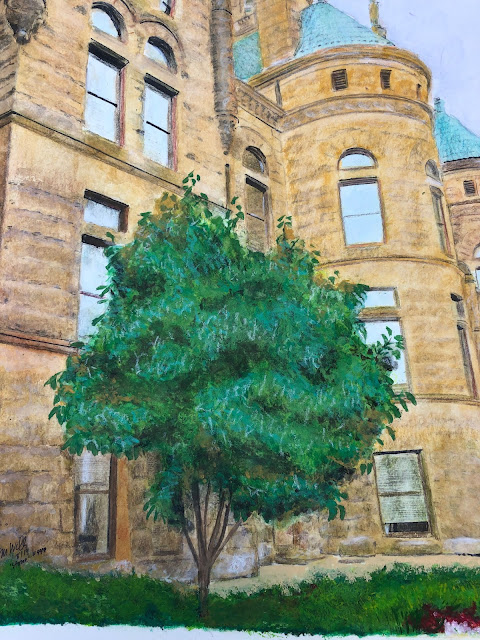 |
| "Stone" by Tom Wills, August 2019. Watercolor and ink, |
So it was fitting that I had to return to the courthouse in August to obtain paperwork that was needed for my “retirement” from my first phase of newspapering. My pension papers from The Vindicator were signed and sealed fully a month before the 150-year-old newspaper ceased publication in downtown Youngstown.
I snapped four photos of the courthouse on my way in to the building. It was a foggy morning and overnight rain had dampened the sandstone and turned the summer grass vivid green. I thought: “Such a beautiful place for sending much of society’s ugliness away.”
The Trumbull County Courthouse is listed on the National Historical Register of the U.S. Department of Interior. According to the county’s own history of the building, the cornerstone was laid on Thanksgiving Day, Nov. 28, 1895. LaBelle and French of Marion, Ind. designed the building and E.M. Campfield of Findley, Ohio did the construction.
It’s Amherst sandstone, from Amherst, Ohio — The Sandstone Center of the World. “The giant stones were sawed to specification at a cutting mill erected in the park,” its history states.
Stone work on the tower began in August 1896, with the copper roof installation beginning in September. “The tower framework was completed on Oct. 22, 1896, with the American flag flown from the superstructure.”
“In November, the courthouse bell, weighing 1,500 pounds, arrived and the tower clocks were put in place.” I climbed to the bell and the clock mechanism three times, in my younger days of running the building, through a back stairway off of one of the courtrooms.
“The ‘statues of justice’ arrived in time for the first statue to be placed on the east gable on March 4, 1897 - William McKinley's Presidential Inauguration Day.” The courthouse was dedicated on May 10, 1897.
Right then, in that fog 122 years later, I knew it would be my next painting. And I knew that I’d make it huge, like the edifice. I had been hoarding away large and heavy sheets of watercolor paper for just such a project. The image is 17.5’’ by 23’’.
It’s not all watercolor painting, however. After drawing the image in pencil I went over certain highlights with black ink, and then painted over those dark guide lines.
I approached each section of the courthouse separately, working on the details from left to right — most prominent and detailed to most distant and vague. That sandstone was done in three phases: A wash of goldenrod, a paper towel blot of dark brown, and another brush-and-blot of white. This created the illusion of individual stones over the pencil sketch.
I used colored pencils for detailing the ripples and folds in the copper roof, and even the blinds in the windows. Then, I painted over that to “seal in” the color.
Last came the landscaping and the tree. The grounds in summer are beautiful with all sorts of flowers brimming in their beds. The tree in the foreground I frankly found a distraction and almost eliminated it from the image. But then, the painting without that tree would not be true to reality.
I would not want to fake 122 years of history.
The tree was sort of a nightmare. Those are my fingerprints all over it, plus six or seven colors, some ink, a few splashes of water, black, white, four brushes, wads of paper towels and one nervous wreck. It worked, somehow.
The shrubbery in the front was created using the side of a toothpick.
* I could find nothing online about a tree dedication at the courthouse, and court personnel including a judge who were asked did not recall. I think it's a tree planted for Parents of Murdered Children, and it occurred some years after one of the especially brutal trials that I covered. If you know, please share.
Prints will be made available of this painting.
This original painting is available. Contact me at willstom01@gmail.com















No comments:
Post a Comment